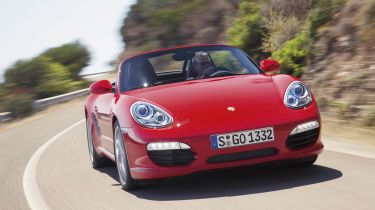Porsche Boxster S
Class-leading roadster has gone under knife – and it’s now better than ever.

From its launch back in 1996, the Boxster has always been a serious driver’s car – and it’s only got better with age. Lower emissions and improved economy make it an even more tempting prospect, and demonstrate Porsche’s willingness to keep up to date in more ways than one. Extra power and sharper dynamics mean it’s even more fun to drive, but the PDK box isn’t as good as it sounds – so a manual is by far the best option. Other than that, the Boxster has once again blown away the opposition. This is a truly excellent sports car.
Just when you thought Porsche had honed its sports cars to perfection, it goes one better! The company’s popular roadster, the Boxster, has had a significant overhaul – and Auto Express got behind the wheel just after its unveiling at the Los Angeles Motor Show.
Blink and you’ll miss the exterior changes –there are new lights and reshaped bumpers front and rear – but the tweaks go far beyond the styling. Porsche has updated the Boxster under the skin too, just as it did with the 911 earlier this year. The entry-level 2.7-litre flat-six has now grown to 2.9 litres, and it benefits from an extra 10bhp, taking the total output to 255bhp.
Used - available now

2016 Porsche
Boxster
21,773 milesAutomaticPetrol3.4L
Cash £50,000
2016 Porsche
Boxster
49,714 milesAutomaticPetrol2.7L
Cash £26,500
2016 Porsche
Boxster
15,118 milesManualPetrol3.8L
Cash £62,000
2016 Porsche
Boxster
94,000 milesAutomaticPetrol2.7L
Cash £21,450The flagship 3.4-litre engine in the Boxster S we drove has also been blessed with Porsche’s latest direct-injection system. This develops an additional 15bhp to increase the power to 310bhp.
But the biggest change is the introduction of the new PDK twin-clutch gearbox from the 911. This replaces the former Tiptronic S transmission, and is the first double-clutch box to be fitted to a mid-engined car. It helped our model shave a tenth of a second off the 0-62mph time of the six-speed manual variant.
Add the optional Sports Chrono Package to the mix, and you’ll get the benefits of launch control. This maximises acceleration potential, and reduces the sprint time by a further two-tenths to five seconds.
Porsche hasn’t only squeezed more performance out of these engines, though. The Boxster is now cleaner and more efficient than ever. Our PDK S emits 41g/km less CO2, with an output of 221g/km, while combined fuel economy is up by 4.4mpg to 30.1mpg.
But this model has always been about driver appeal, and the latest version delivers. Fire up the flat-six and you’re met with a distinctive bark that’s a little higher pitched than before, and intensifies as the revs rise.
The handling is second to none. Engineers have tinkered with the already excellent suspension set-up to further sharpen the ride. Plus, the brakes have been enhanced with extra electronic assistance during heavy braking, increasing feel and stopping power.
Thankfully, the Boxster has retained its super-communicative steering, and the PDK box changes ratios swiftly and precisely. There are three shift options – normal, Sport and track-focused Sport Plus – although as with the 911, the wheel-mounted controls are counter-intuitive. You can’t help but think that it would benefit from a paddleshift arrangement. On paper, the PDK-equipped Boxster is marginally faster than the standard car, but keen drivers would no doubt prefer a manual transmission.
Point the Boxster away from winding tarmac, and it’s just as impressive. In town, it’s comfortable and easy to drive. Sports car fans and driving enthusiasts should form an orderly queue.
Rival: Mercedes SLK
with a great soundtrack, good looks and a rewarding driving experience, the SLK is a strong choice. But it’s softer and not as focused as the Porsche – so is more suited to drivers who put luxury ahead of entertainment.







